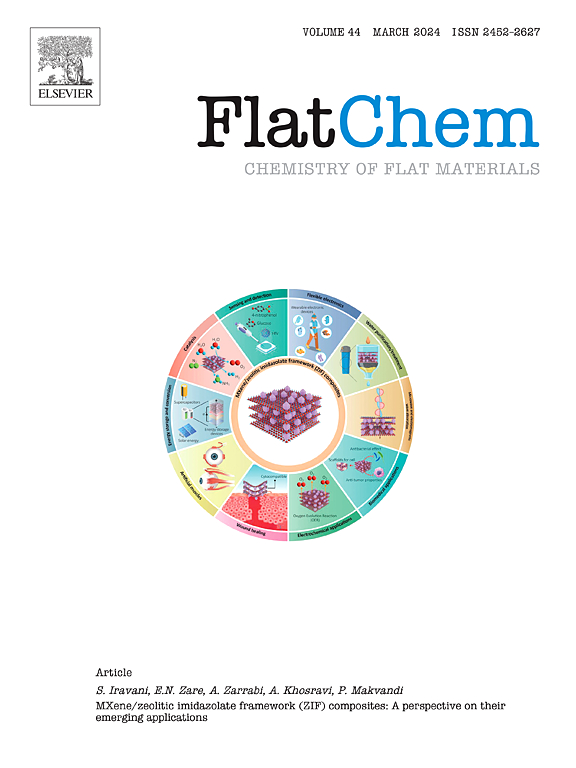Boron phosphide (BP) graphenylene as work function-type sensor for glucose detection: First-principles investigations
IF 5.9
3区 材料科学
Q2 CHEMISTRY, PHYSICAL
引用次数: 0
Abstract
Diabetes is a chronic metabolic disorder characterized by elevated blood sugar levels, leading to severe health complications. Non-invasive glucose monitoring is essential for effective diabetes management, and porous materials are promising candidates for this purpose due to their high surface-to-volume ratio and the availability of active sites for adsorption. In this study, we explore the potential of g-BP (graphenylene-like boron phosphide) as a non-enzymatic glucose sensor. Adsorption energies (E) for glucose, fructose, and xylose on gaseous (aqueous) media were calculated as −0.74 eV (−1.13 eV), −0.66 eV (−1.04 eV), and −0.58 eV (−1.07 eV), respectively, with the sugar molecules chemisorbed on the g-BP surface. The variations on E when water molecules are present are due to hydrogen bonding interactions between HO and the sugars. Recovery time results indicate that the g-BP monolayer can be utilized as a reusable sensor for these sugar molecules with high selectivity. A band gap opening of approximately 0.67 eV is observed under the adsorption of all sugar molecules. Notably, the work function () of g-BP changes significantly upon glucose adsorption for both gaseous and aqueous environments, making it highly sensitive for glucose detection. These findings suggest that g-BP is a promising material for non-invasive work function glucose sensors, as well as for diabetes management.

磷化硼 (BP) 石墨苯作为功函数型传感器用于葡萄糖检测:第一原理研究
糖尿病是一种慢性代谢性疾病,其特点是血糖水平升高,会导致严重的健康并发症。无创血糖监测对于有效控制糖尿病至关重要,而多孔材料因其高表面体积比和活性吸附位点的可用性而有望实现这一目的。在本研究中,我们探讨了 g-BP(类石墨烯磷化硼)作为非酶葡萄糖传感器的潜力。计算得出葡萄糖、果糖和木糖在气态(水态)介质上的吸附能(Eads)分别为-0.74 eV (-1.13 eV)、-0.66 eV (-1.04 eV) 和 -0.58 eV (-1.07 eV),糖分子在 g-BP 表面上的化学吸附能分别为-0.74 eV (-1.13 eV)、-0.66 eV (-1.04 eV) 和 -0.58 eV (-1.07 eV)。存在水分子时,Eads 的变化是由于 H2O 与糖之间的氢键相互作用造成的。恢复时间结果表明,g-BP 单层可用作这些糖分子的可重复使用传感器,并具有很高的选择性。在所有糖分子的吸附作用下,都观察到了约 0.67 eV 的带隙开口。值得注意的是,在气态和水态环境中,g-BP 的功函数(ϕ)在吸附葡萄糖后会发生显著变化,从而使其对葡萄糖检测具有高灵敏度。这些研究结果表明,g-BP 是一种很有前途的非侵入性功函数葡萄糖传感器材料,也可用于糖尿病管理。
本文章由计算机程序翻译,如有差异,请以英文原文为准。
求助全文
约1分钟内获得全文
求助全文
来源期刊

FlatChem
Multiple-
CiteScore
8.40
自引率
6.50%
发文量
104
审稿时长
26 days
期刊介绍:
FlatChem - Chemistry of Flat Materials, a new voice in the community, publishes original and significant, cutting-edge research related to the chemistry of graphene and related 2D & layered materials. The overall aim of the journal is to combine the chemistry and applications of these materials, where the submission of communications, full papers, and concepts should contain chemistry in a materials context, which can be both experimental and/or theoretical. In addition to original research articles, FlatChem also offers reviews, minireviews, highlights and perspectives on the future of this research area with the scientific leaders in fields related to Flat Materials. Topics of interest include, but are not limited to, the following: -Design, synthesis, applications and investigation of graphene, graphene related materials and other 2D & layered materials (for example Silicene, Germanene, Phosphorene, MXenes, Boron nitride, Transition metal dichalcogenides) -Characterization of these materials using all forms of spectroscopy and microscopy techniques -Chemical modification or functionalization and dispersion of these materials, as well as interactions with other materials -Exploring the surface chemistry of these materials for applications in: Sensors or detectors in electrochemical/Lab on a Chip devices, Composite materials, Membranes, Environment technology, Catalysis for energy storage and conversion (for example fuel cells, supercapacitors, batteries, hydrogen storage), Biomedical technology (drug delivery, biosensing, bioimaging)
 求助内容:
求助内容: 应助结果提醒方式:
应助结果提醒方式:


